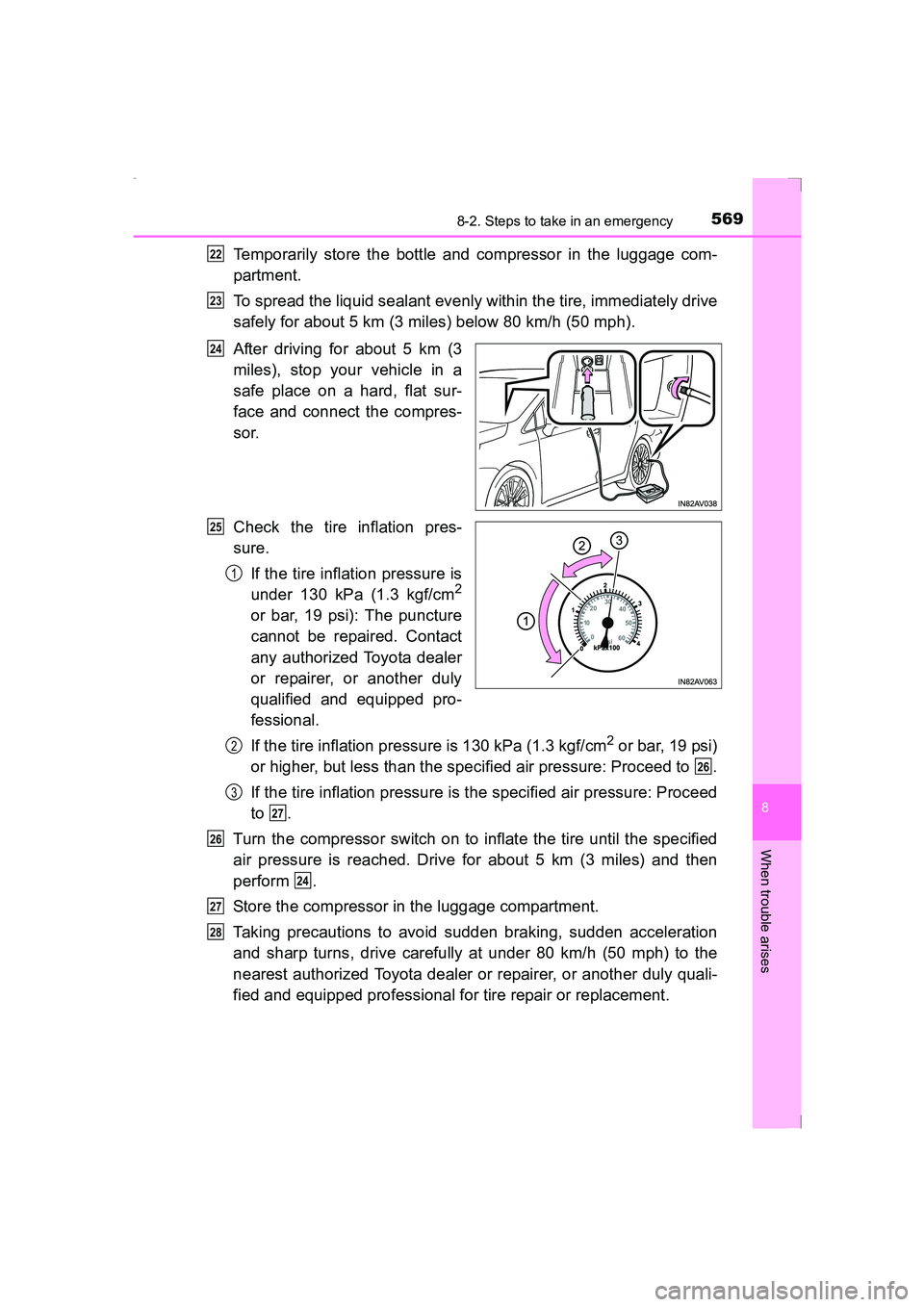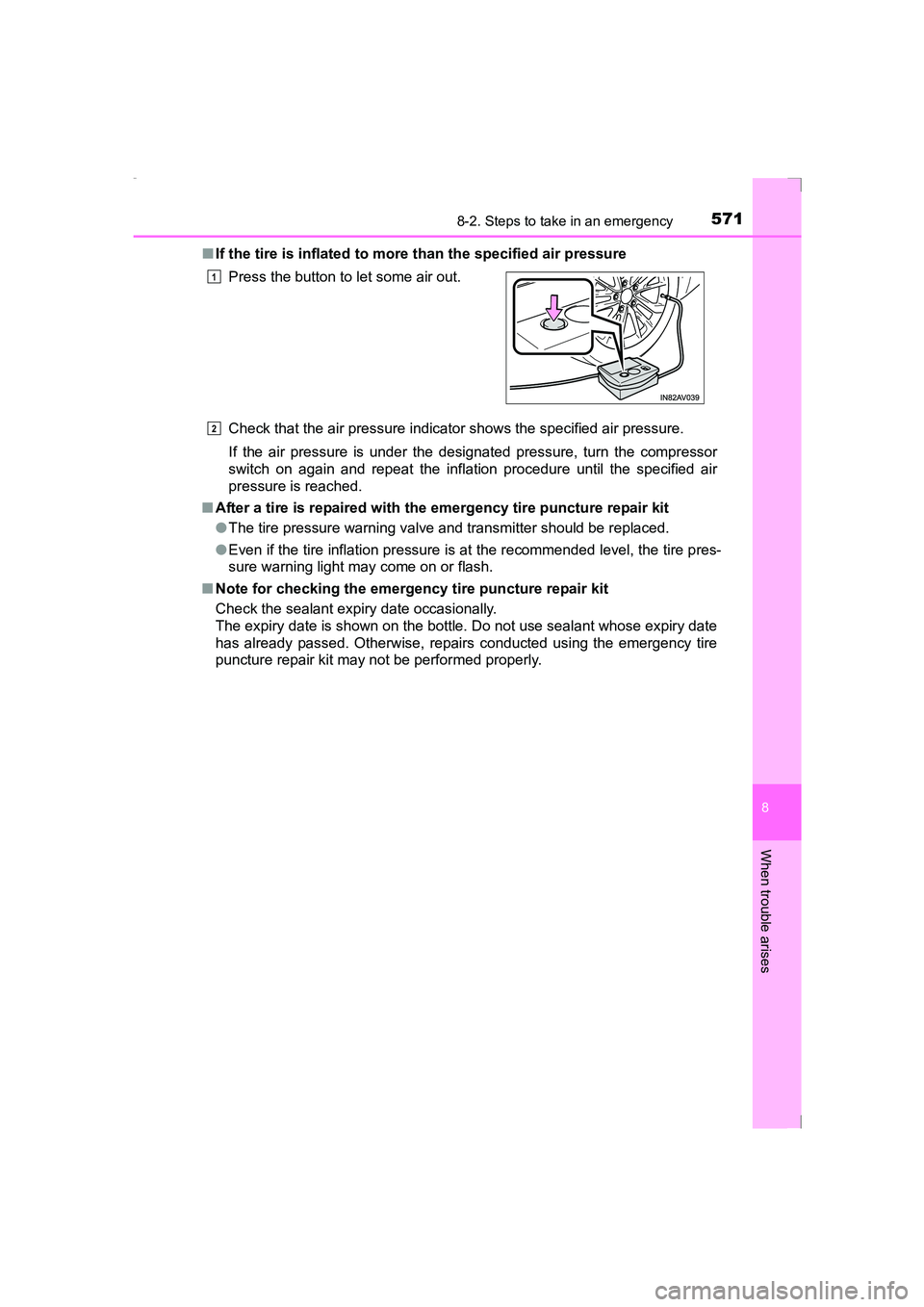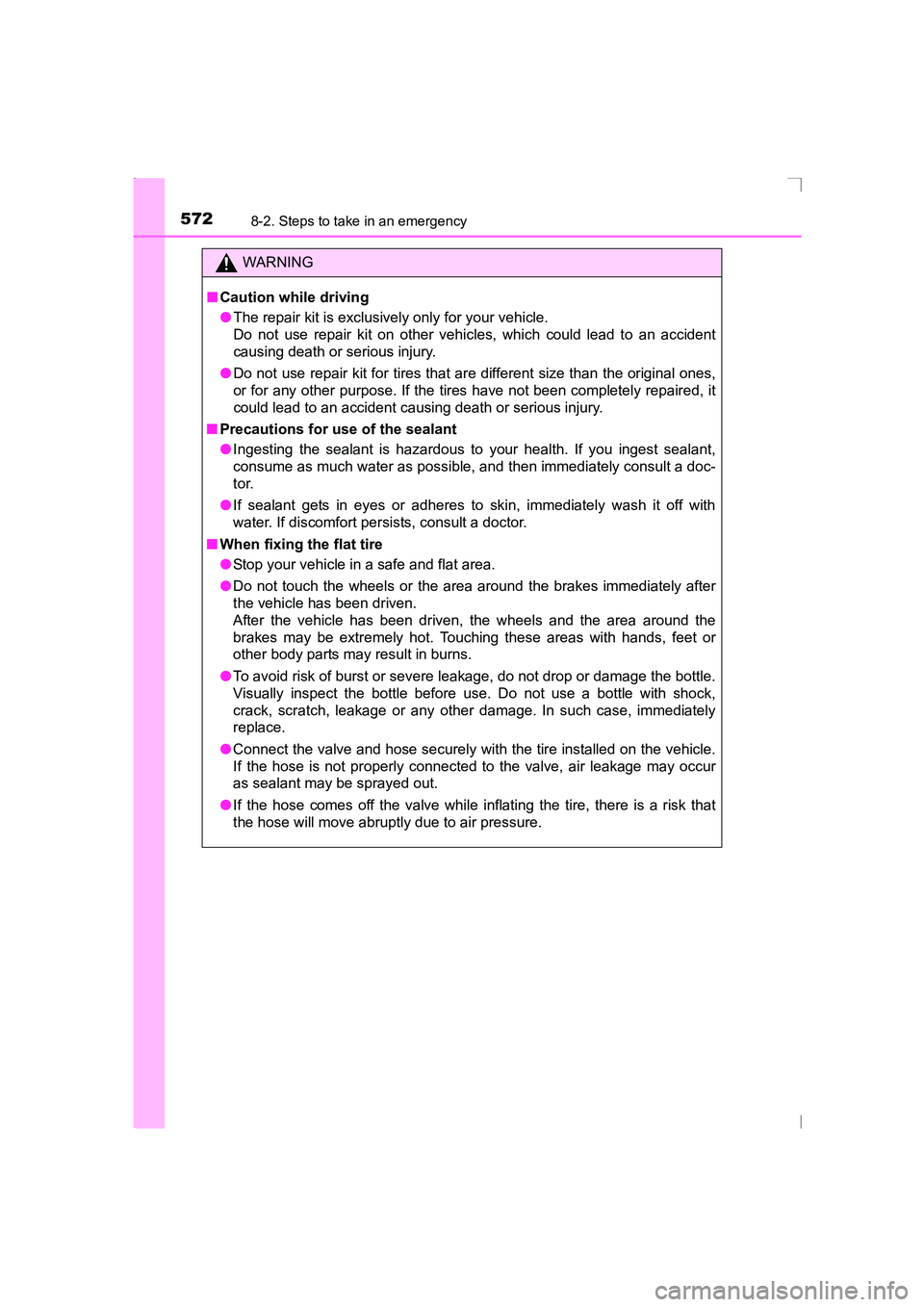Page 566 of 648
5668-2. Steps to take in an emergency
AVENSIS_OM_OM20C20E_(EE)
Make sure that the compressor
switch is off.
Remove the power plug from
the compressor.
Connect the power plug to the
power outlet socket. (→P. 418)
Check the specified tire inflation pressure.
Tire inflation pressure is specified on the label as shown.
Start the vehicle’s engine.
9
10
11
12
�XLeft-hand drive vehicles�XRight-hand drive vehicles
13
AVENSIS_OM_OM20C20E_(EE).book Page 566 Thursday, January 29, 2015 1:47 PM
Page 567 of 648

5678-2. Steps to take in an emergency
AVENSIS_OM_OM20C20E_(EE)
8
When trouble arises
To inject the sealant and inflate
the tire, turn the compressor
switch on.
Inflate the tire until the specified
air pressure is reached.The sealant will be injected
and the pressure will surge
and then gradually decrease.
The air pressure gauge will
display the actual tire infla-
tion pressure about 1 minute
(5 minutes at low tempera-
ture) after the switch is
turned on.
Inflate the tire until the speci-
fied air pressure is reached.• If the tire inflation pressure
is still lower than the speci-
fied point after inflation for
35 minutes with the switch
on, the tire is too damaged
to be repaired. Turn the
compressor switch off and
contact any authorized
Toyota dealer or repairer,
or another duly qualified
and equipped profes-
sional.
• If the tire inflation pressure exceeds the specified air pressure,
let out some air to adjust the tire inflation pressure. ( →P. 571)14
15
1
2
3
AVENSIS_OM_OM20C20E_(EE).book Page 567 Thursday, January 29, 2015 1:47 PM
Page 569 of 648

5698-2. Steps to take in an emergency
AVENSIS_OM_OM20C20E_(EE)
8
When trouble arises
Temporarily store the bottle and compressor in the luggage com-
partment.
To spread the liquid sealant evenly within the tire, immediately drive
safely for about 5 km (3 miles) below 80 km/h (50 mph).
After driving for about 5 km (3
miles), stop your vehicle in a
safe place on a hard, flat sur-
face and connect the compres-
sor.
Check the tire inflation pres-
sure.If the tire inflation pressure is
under 130 kPa (1.3 kgf/cm
2
or bar, 19 psi): The puncture
cannot be repaired. Contact
any authorized Toyota dealer
or repairer, or another duly
qualified and equipped pro-
fessional.
If the tire inflation pressure is 130 kPa (1.3 kgf/cm
2 or bar, 19 psi)
or higher, but less than the specified air pressure: Proceed to .
If the tire inflation pressure is the specified air pressure: Proceed
to .
Turn the compressor switch on to inflate the tire until the specified
air pressure is reached. Drive for about 5 km (3 miles) and then
perform .
Store the compressor in the luggage compartment.
Taking precautions to avoid sudden braking, sudden acceleration
and sharp turns, drive carefully at under 80 km/h (50 mph) to the
nearest authorized Toyota dealer or repairer, or another duly quali-
fied and equipped professional for tire repair or replacement.
22
23
24
25
1
2
26
3
27
26
24
27
28
AVENSIS_OM_OM20C20E_(EE).book Page 569 Thursday, January 29, 2015 1:47 PM
Page 571 of 648

5718-2. Steps to take in an emergency
AVENSIS_OM_OM20C20E_(EE)
8
When trouble arises
■If the tire is inflated to mo re than the specified air pressure
Check that the air pressure indicator shows the specified air pressure.
If the air pressure is under the designated pressure, turn the compressor
switch on again and repeat the inflation procedure until the specified air
pressure is reached.
■ After a tire is repaired with the emergency tire puncture repair kit
●The tire pressure warning valve and transmitter should be replaced.
● Even if the tire inflation pressure is at the recommended level, the tire pres-
sure warning light may come on or flash.
■ Note for checking the emergency tire puncture repair kit
Check the sealant expiry date occasionally.
The expiry date is shown on the bottle. Do not use sealant whose expiry date
has already passed. Otherwise, repairs conducted using the emergency tire
puncture repair kit may not be performed properly.Press the button to let some air out.
1
2
AVENSIS_OM_OM20C20E_(EE).book Page 571 Thursday, January 29,
2015 1:47 PM
Page 572 of 648

5728-2. Steps to take in an emergency
AVENSIS_OM_OM20C20E_(EE)
WARNING
■ Caution while driving
●The repair kit is exclusively only for your vehicle.
Do not use repair kit on other vehicles, which could lead to an accident
causing death or serious injury.
● Do not use repair kit for tires that are different size than the original ones,
or for any other purpose. If the tires have not been completely repaired, it
could lead to an accident causing death or serious injury.
■ Precautions for use of the sealant
●Ingesting the sealant is hazardous to your health. If you ingest sealant,
consume as much water as possible, and then immediately consult a doc-
tor.
● If sealant gets in eyes or adheres to skin, immediately wash it off with
water. If discomfort persists, consult a doctor.
■ When fixing the flat tire
●Stop your vehicle in a safe and flat area.
● Do not touch the wheels or the area around the brakes immediately after
the vehicle has been driven.
After the vehicle has been driven, the wheels and the area around the
brakes may be extremely hot. Touching these areas with hands, feet or
other body parts may result in burns.
● To avoid risk of burst or severe leakage, do not drop or damage the bottle.
Visually inspect the bottle before use. Do not use a bottle with shock,
crack, scratch, leakage or any other damage. In such case, immediately
replace.
● Connect the valve and hose securely with the tire installed on the vehicle.
If the hose is not properly connected to the valve, air leakage may occur
as sealant may be sprayed out.
● If the hose comes off the valve while inflating the tire, there is a risk that
the hose will move abruptly due to air pressure.
AVENSIS_OM_OM20C20E_(EE).book Page 572 Thursday, January 29, 2015 1:47 PM
Page 573 of 648

5738-2. Steps to take in an emergency
AVENSIS_OM_OM20C20E_(EE)
8
When trouble arises
WARNING
■ When fixing the flat tire
●After inflation of the tire has completed, the sealant may splatter when the
hose is disconnected or some air is let out of the tire.
● Follow the operation procedure to repair the tire. If the procedures not fol-
lowed, the sealant may spray out.
● Keep back from the tire while it is being repaired, as there is a chance of it
bursting while the repair operation is being performed. If you notice any
cracks or deformation of the tire, turn off the compressor switch and stop
the repair operation immediately.
● The repair kit may overheat if operated for a long period of time. Do not
operate the repair kit continuously for more than 40 minutes.
● Parts of the repair kit become hot during operation. Be careful when han-
dling the repair kit during and after operation. Do not touch the metal part
around the connecting area between the bottle and compressor. It will be
extremely hot.
● Do not attach the vehicle speed warning sticker to an area other than the
one indicated. If the sticker is attached to an area where an SRS airbag is
located, such as the pad of the steering wheel, it may prevent the SRS air-
bag from operating properly.
■ Driving to spread the liquid sealant evenly
Observe the following precautions to reduce the risk of accidents.
Failing to do so may result in a loss of vehicle control and cause death or
serious injury.
●Drive the vehicle carefully at a low speed. Be especially careful when turn-
ing and cornering.
● If the vehicle does not drive straight or you feel a pull through the steering
wheel, stop the vehicle and check the following:
• Tire condition. The tire may have separated from the wheel.
• Tire inflation pressure. If the tire inflation pressure is 130 kPa (1.3 kgf/cm
2
or bar, 19 psi) or less, the tire may be severely damaged.
AVENSIS_OM_OM20C20E_(EE).book Page 573 Thursday, January 29, 2015 1:47 PM
Page 578 of 648

5788-2. Steps to take in an emergency
AVENSIS_OM_OM20C20E_(EE)
If the parking brake cannot be released
●Vehicles with Multidrive: Shift the shift lever to P.
● Vehicles with manual transmission: Shift the shift lever to 1 or R.
● Turn the engine switch to the “LOCK” position (vehicles without
smart entry & start system) or off (vehicles with smart entry & start
system).
● Check that the parking brake indicator is off.
● Chock the tires.
● Stop the vehicle on a hard, flat surface.
In the event that the battery is discharged or switch operation
does not release the parking brake, the parking brake can be
released manually using the procedure below. This procedure
should be performed only if necessary, such as in an emer-
gency.
If the switch cannot be operated even when the battery is nor-
mal, the parking brake system may be malfunctioning. Have the
vehicle inspected by any authorized Toyota dealer or repairer, or
another duly qualified and equipped professional immediately.
Before releasing the parking brake manually
AVENSIS_OM_OM20C20E_(EE).book Page 578 Thursday, January 29, 2015 1:47 PM
Page 613 of 648
6139-1. Specifications
AVENSIS_OM_OM20C20E_(EE)
9
Vehicle specifications
�X225/45R18 95W
�X215/55R17 94W
Tires and wheels
Tire size 225/45R18 95W
Tire inflation pressure
(Recommended cold tire
inflation pressure)Vehicle
speed
Front wheel
kPa (kgf/cm
2
or bar, psi) Rear wheel
kPa (kgf/cm2
or bar, psi)
More than
160 km/h
(99 mph) 280 (2.8, 41) 250 (2.5, 36)
160 km/h
(99 mph) or
less 250 (2.5, 36) 230 (2.3, 33)
Wheel size 18
× 7 1/2J
Wheel nut torque 103 N•m (10.5 kgf•m, 76 ft•lbf)
Tire size 215/55R17 94W
Tire inflation pressure
(Recommended cold tire
inflation pressure) Vehicle
speed
Front wheel
kPa (kgf/cm
2
or bar, psi) Rear wheel
kPa (kgf/cm2
or bar, psi)
More than
160 km/h
(99 mph) 270 (2.7, 39) 250 (2.5, 36)
160 km/h
(99 mph) or
less 240 (2.4, 35) 230 (2.3, 33)
Wheel size 17
× 7J
Wheel nut torque 103 N•m (10.5 kgf•m, 76 ft•lbf)
AVENSIS_OM_OM20C20E_(EE).book Page 613 Thursday, January 29, 2015 1:47 PM